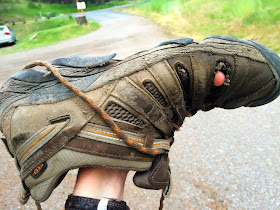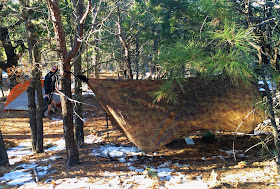On this, our second trip to Guadalupe Mountains National Park in west Texas, Pathfinder and I explored McKittrick Canyon via two overnight trips—first to McKittrick Ridge and then to Wilderness Ridge on the Permian Reef Geology Trail.
The grande finale of our Texas trip— the Permian Reef Geology Trail. It became an immediate favorite because of the fascinating interpretive information about the geologic history along the 2000 foot climb. At each of the 28 interpretive stops over about 4 miles, we learned about how the Guadalupe Mountains are exposed fossil reefs from the Permian period (280-250 million years ago). It was amazing to see how the algae, sponges, and other organisms built these mountains.
 |
| Reading the guidebook to understand the formation of this ancient reef. Photo by Pathfinder |
What made this hike exceptional was having a guidebook to direct our observations and fuel our imaginations (
"Listening to the Rocks" - see below). Signed interpretive stops pointed out diverse fossils. Soon, we developed a search image for spotting fossils, and they jumped out everywhere. Had we just walked past all these fossils just this morning on the climb down from McKittrick Ridge? Apparently, yes… but we hadn't noticed them.
 |
| It'd be easy to walk right over these fossilized stramatolites- made by algae- until you learn to spot them. |
Finding fossils embedded in rocks out in nature, rather than in a classroom or museum, made them come alive. The guidebook showed pictures of how the ancient plants and animals looked and told about what they ate and how they lived.
How could something so small as algae and sponges possibly build mountains? As we set one foot in front of the other on the long climb, we had time to imagine how it could be possible for algae and coral to build a reef millimeter by millimeter over the course of a few million years.
It was also incredible to wonder about the Permian mass extinction after seeing fossil remains of the creatures that went extinct. 95% of all plants and animals went extinct 225 million year ago.
95%! And all of life on earth now is descended from those 5% that survived.
 |
| Getting a better view of the fossils. Photo by Pathfinder |
Understanding how environments can be different over time— like how
this area of Texas could have been near the equator and covered by an
ancient sea—can be tricky too. Until you stand on the rim with the wind blowing and soak in the expansive views... then it's easier to imagine waves crashing over this sea
filled with ancient life here.
 |
| On the rim |
This interpretive trail enriched my experience of the Guadalupe Mountains and provided fuel for thought during the hours that we took climbing. I felt wonder at how these mountains formed, and a connection to all the living things that made this place their home so long ago. If you are interested in geology or if you like learning about nature (and don't mind strenuous climbs), then head to this trail in far west Texas!
More Trip InformationStop by the Pine Springs Visitor Center
Get your backcountry camping permit, buy the guidebook, check gate closure times, and get up to date trail information.
Buy “Listening to the Rocks: A Young Person’s Guide to the Permian Reef Trail"
While the free “Permian Reef Trail Guide” describes geological highlights of select stops (available to download
here), its worth it to spend the $5 to get this excellent, comprehensive, detailed guide. The interpretive guidebook says the book is aimed at young people, but the book is detailed enough to to be highly interesting to someone who appreciates depth. The fact that it is aimed at young people made it fun to read for anyone young at heart.
 |
| Photo by Pathfinder |
Be prepared for a big climb in full sun
The large elevation change and fact that the hike offers no shade make it less suitable for younger children. Note that because this is a dayuse area and they don’t open the gate until 8 AM, you can’t start early to beat the heat. Even though winter provided us with cooler temperatures, Pathfinder and I both hid in the shade of our umbrellas to stay cooler until after we crossed over the saddle into the afternoon shade. Earlier in the day, the trail would have had even more exposure.
 |
| Pathfinder using her sun umbrella |
Wilderness Ridge Backcountry Campsite
Pathfinder and I opted to stay overnight at the Wilderness Ridge Backcountry Campsite, which was another 30 or so minutes beyond the end of the geology trail. Wilderness Ridge was more exposed and windy than McKittrick
Ridge had been, but was just 5 minutes to this incredible rocky overloop with a view across McKittrick Canyon. This campsite didn't seem like it gets much use-- and we had it all to ourselves.



















































